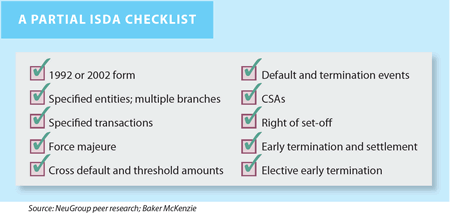
Understanding the standard document used to govern over-the-counter derivatives transactions.
Based on many discussions with practitioners in NeuGroup peer groups, here is a checklist of things to consider when implementing ISDA Master Agreements (ISDAs).
One of the first considerations is whether it is worth bothering to set up an ISDA with every counterparty.
- Only value-add banks, please. With limited trading capacity to spread around—as well as treasury bandwidth—practitioners agreed that firms should focus on the banks that are able to add real value from an dealer standpoint. If they don’t, why waste time and energy on negotiating an ISDA?
- Invest in a good ISDA template. Many treasurers also agreed that it is worth the money to pay a specialist attorney to create an ISDA template. This could be used as a starting point for negotiations with counterparties (or ending point, if firms are prepared to walk away if a bank does not accept the basic tenets of the template agreement).
Consensus has it that a template should be doable for anywhere from $50-100K in legal fees (fees should be coming down as more corporates turn to ISDAs and the more corporate-oriented clauses become part of law firms starter templates).
The need to involve internal counsel to cross-check these templates might raise the legal costs. Finally, while the first instinct might be to limit the ISDA to FX, it usually is more effective to consider the broader counterparty risk across asset classes, when preparing the template.
- Choose your vintage. It pays to keep track of what the major differences are between the different “vintages” of ISDA templates (in practice, 1992 or 2002; see sidebar below), and be prepared to argue for the “preferred” one. Several members have mentioned how hard it is these days to have all their banks of the same vintage but that they have still been reasonably successful.
“We try to keep them standard,” said a treasury head whose company is “99 percent” on 2002 ISDAs; another has managed to keep all its banks to 1992 ISDAs. Marc A. Horwitz, an attorney formerly with Baker McKenzie (now with DLA Piper), noted: “For end users (corporates), we prefer 1992, particularly for FX trading.”
- Banks are different. Each bank has a different risk tolerance and will focus on different areas, such as the definition of early termination, settlement, or credit committee concerns. Overall, members agree that non-US banks are harder than US banks, and Japanese banks, for example, are very conservative.
- Don’t hesitate to stick to your guns. Treasury should not be afraid to play hardball with banks when negotiating their ISDAs, or if they are up for renewal. One way is the template approach; another is to flag the clauses that are a source for concern and stand firm regarding those. Check with senior management of course, but if you don’t like the terms a bank is offering, be prepared to say “no thanks” and walk away.
Also, just as banks have their pet peeves about what they consider important aspects of the ISDA to protect themselves, in the end, said one FX risk director, “you have to carve out various aspects of the [ISDA] contract you don’t like.”
- Beware multiple-branch clauses. When specifying entities covered by the ISDA in the “schedule,” it is also important to be clear on the language on multiple branches, as this can help determine whether it’s better to book trades, for example, with the local Citi branch or Citi New York. One FX director noted that no matter which branch executes his company’s deals they are always “booked” with the London entity of the trading bank. One of his peers in the NeuGroup’s European Treasurers’ Peer Group (EuroTPG) agreed: “We insist on dealing with the main bank or branch, nobody else.”
Whether pricing is influenced by where the trade is executed is something to watch out for. A firm in the large-cap bracket with a bank in one region of the world may be covered by the medium-cap group in another, due to the relative size of its presence there. This could be true for one or several banks.
Banks should also not be allowed to book trades from branches located in jurisdictions which prohibit offshore FX transactions unless the ISDA is in the name of the onshore sub.

OTHER CRITICAL CONSIDERATIONS
- Cross-default thresholds. A cross-default provision (under which all outstanding trades covered by the ISDA can be terminated if the counterparty defaults on third-party debt) can be elected in the ISDA schedule, but firms should consider whether to have it. When opting for the provision, it is important to set a threshold amount such that a cross default is not triggered unnecessarily by technical but not material events, and is not lower than existing credit agreements’ cross-default thresholds.
- Termination settlements. In the 1992 ISDA form (see below), there are two methods for calculating an early termination settlement (triggered by “default” and “termination” events defined in the contract):
1) “Loss” (or “unpaid amounts”); and
2) “Market quotation.”
The former considers the amount that would make the counterparty whole on the trade. The latter requires four market quotes and the ultimate price is the average of the two middle quotes.
“Some corporates take strong views on which they prefer,” noted Mr. Horwitz, based on their experience with closeouts or what types of trade they plan to use most.
Market quotes work well for vanilla trades because it’s considered likely the trades will be priced fairly. The “loss” method works better for highly structured trades.
- Confirmation supersedes ISDA. After a few corporate derivatives debacles in the 1990s, banks favor inserting a “non-reliance clause” into the 1992 ISDA (it is in the pre-printed 2002 form) in which the bank basically says “you (the company) know what you’re doing, so we’re not responsible.”
Very few corporates manage to negotiate out of the non-reliance clause. Because trade confirmations supersede ISDAs, those that don’t have the clause should take extra care that the clause does not get reinserted into the trade confirmations.
On the other hand (and this is another “score” for SWIFT), a corporate practitioner pointed out that using SWIFT confirmations helps in this regard as there is “not much room for sticking in additional terms or changes.”
THE TABLES ARE TURNED
While ISDAs may have been insisted on by banks in the past, it is now corporates that are scrutinizing them to ensure they are properly protected when banks look vulnerable. Firms, therefore, should take extra precautions to guard against events that may work against them at some future point in a trading relationship, when banks again look less vulnerable, starting with a mutually agreeable ISDA.
WINE AND ISDAS: VINTAGE MATTERS
Should a firm opt for the 1992 or 2002 form of ISDA? The major differences between the two, said Baker McKenzie (now DLA Piper) attorney Marc. A. Horwitz, are:
Grace period for failure to pay. The grace period in the 1992 form is three business days, in the 2002, only one. For treasuries with limited bandwidth, three days’ grace can prevent mistakes and non-payments not due to credit default events from unduly punishing the firm or result in terminated trades.
Scope. The 2002 form includes a broader range of specified transactions, such as repos, reverse repos and securities loans. “For corporates, we generally prefer 1992; you don’t want an unexpected event in a non-ISDA trade to permit the bank to unwind this ISDA trade,” Mr. Horwitz said.
Force majeure. The 2002 form has a force majeure clause which governs termination of trades that are impossible to make payments on, after an eight business-day waiting period.
Right of set-off. The pre-printed 2002 form includes a set-off provision, which the 1992 form does not (it can be inserted).
Settlement. The 1992 form permits “loss” or “market quotation” as basis for the settlement price upon early termination. The 2002 form has a pre-determined method, a “hybrid” between the two, which doesn’t require four market quotes. There have been efforts within ISDA to migrate end users to the close-out amount, and while firms on the 1992 form can opt for this protocol, it “hasn’t taken that well with corporates,” Mr. Horwitz noted.
ELECTIVE EARLY TERMINATION
As counterparty risk concerns remain pronounced both on the corporate and the bank side, corporates are reporting that banks are showing increasing interest in inserting an elective-termination clause into the ISDA (in the Other Provisions section).
For example, one bank has requested to insert it into a 1992 ISDA master with a corporate, which would allow either side to terminate a derivative six months after inception, and every six months thereafter.
The concern with such a clause is that the company is at risk of the bank terminating a long-term hedge by invoking this clause, leaving the company unhedged. This could cause unintended cash-flow consequences and, more importantly, problems with the hedge qualifying for hedge accounting treatment even at inception.
While the ISDA forms have specified “default” and “termination” events that are standard and bilateral, elective early termination clauses are not common, nor are they recommended in an ISDA governing a relationship, and that may cover a multitude of trades over a long period of time. Former Baker McKenzie (now DLA Piper) ISDA attorney Marc A. Horwitz pointed out that, absent a compelling regulatory or credit reason for such a clause, corporates should push back on banks trying to insert it.
A hedge, after all, is for protecting the corporation, not the bank, as a risk manager pointed out, and corporates already have a way to get out of hedges: by unwinding them; this, however, should be the firm’s decision, not the bank’s.


